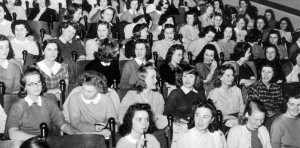There has been an ongoing conversation taking place here at Vassar College, about the role of the computer in the classroom. At a time when technology seems ubiquitous, there are still very strong opinions on the pros and cons of students using laptops in class. These range from those focused on the “chalk and talk” method to having highly digital classrooms. To me this is not a discussion of right or wrong, but a question of appropriateness, especially when trying to create an atmosphere of engaged learning.
One place where I feel that digital technology can make a major impact is the large lecture hall. Typically, these spaces are about the transmission of information from faculty to student. The relationship is directional, emanating from the lectern or chalkboard to the eyes and ears of students. At an early stage in a college career, this is a vital transaction, providing a foundation for the years to come. The lecture hall is a standard on every campus and will continue to be for many years. Concerns arise, however, as the computer begins to invade this space, allowing students’ minds to wander to their ever-growing social network. So, what can be done to maintain focus and build on the possibilities of the information being provided?
One idea that I’ve been thinking about for several years is the “back channel.” No, I’m not going to talk about some grimy alleyway to place misbehaving students in. What I would like to consider is a virtual space, organized and developed by students, that allows them to engage in conversation, ask questions, and bring their own perspective to what had been a one-sided conversation. This online space would allow for the class presentation to be viewed alongside other modes of communication. After a cursory review, an instructor might then bring some of these topics into the conversation when meeting with smaller groups. There are also significant possibilities for those students who are just a bit too shy to raise their hands.
With Powerpoint and Adobe Connect developing webcasting capabilities, this idea is already a possibility. A recent New York Times article discussed options and identified initiatives at several universities to create just such a space.
No matter which side of the conversation you fall on, may it be chalkboard or webboard, the important thing is to find modes of teaching that allow students to engage. It is about making the information meaningful, not just for meaning’s sake, but in such a way that the student can make it a part of their own personal experience. Providing modes of response accomplishes this objective.






